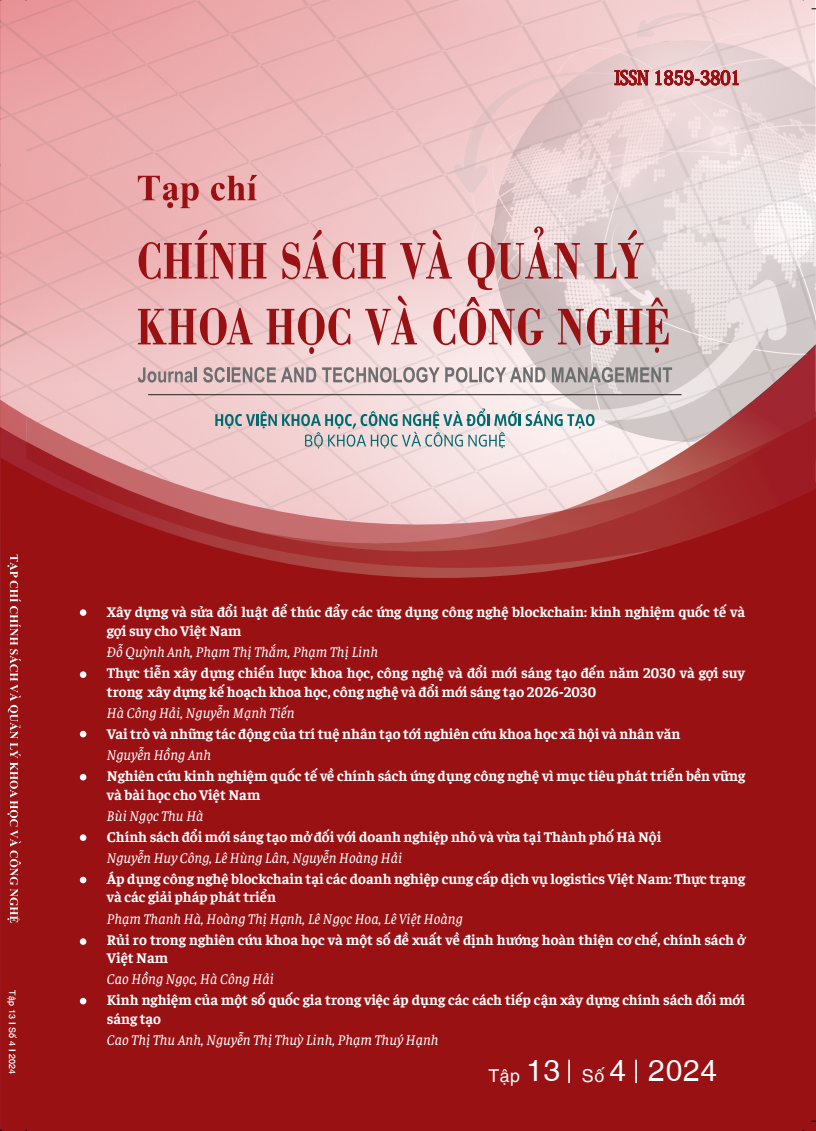Experiences of foreign countries in applying approaches to innovation policy development
Keywords:
Innovation Policy, Transformative Innovation, Innovation SystemAbstract
This study analyzes the experiences of Sweden, Finland, and China in adopting various approaches to innovation policy development, drawing useful lessons for Vietnam. Through the phases of evolving innovation policy approaches - from focusing on economic growth to building national innovation systems and pursuing sustainable development - all three countries have implemented effective strategies tailored to their specific contexts. Sweden emphasizes the role of fundamental research and interdisciplinary collaboration, Finland has established a robust innovation system, while China focuses on institutional reforms and technology transfer. The article proposes that Vietnam's innovation policy should strengthen investment in fundamental research, especially in high-tech sectors, foster closer connections among stakeholders, and promote the application of science and technology (S&T) for sustainable economic development.
Code: 24120302
Downloads
References
Arnold, E. & Barker, K.E. (2022), “What past changes in Swedish policy tell us about developing third-generation research and innovation governance” in Benner, M., Marklund, G. & Schwaag-Serger, S. (ed.) Smart Policies for Societies in Transition. https://doi.org/10.4337/9781788970815.00009
CGTN (2020), “Five-Year Plans map out China’s future development” [WWW Document]. URL: https://news.cgtn.com/news/2020-05-15/Five-Year-Plans-map-out-China-s-future-development-QvANs2JxVS/index.html (accessed 12.16.20).
CPC and State Council (2015), “Guānyú shēnhuà tǐzhì jīzhì gǎigé jiākuài shíshī chuàngxīn qūdòng fāzhǎn zhànlüè de ruògān yìjiàn” (Opinion on Deepening the Reform of Systems and Mechanisms to Accelerate the Implementation of Innovationdriven Development Strategy) [WWW Document].
CPC, (1985) “Zhōnggòng zhōngyāng guānyú kēxué jìshù tǐzhì gǎigé de juédìng” (Decision on the Reform of the Science and Technology System).
Hermans, R., Kulvik, M., & Ylä-Anttila, P. (2005). International mega-trends and growth
prospects of the Finnish biotechnology industry: Recent economic research and policy
implications. Journal of Commercial Biotechnology, 11, 134-145.
Hernesniemi, H., Lammi, M., & Ylä-Anttila, P. (1995). Kansallinen kilpailukyky ja teollinen tulevaisuus [National competitiveness and the industrial future]. Etla/Sitra.
Hu, J., (2007), “Hújǐntāo zài dǎng de shíqī dà shàng de bàogào” (Hu Jintao’s Report at the 17th CPC National Congress) [WWW Document].
Hu, J., (2012) “Hújǐntāo zài dǎng de shíbā dà shàng de bàogào” (Hu Jintao’s Report at the 18th CPC National Congress) [WWW Document].
Lundvall (1992), National systems of innovation: Towards a theory of innovation and interactive learning. Pinter.
Mu, R. (2019) “Mù róng píng: Zhōngguó chuàngxīn fāzhǎn huígù yǔ zhǎnwàng” (Mu Rongping: Retrospect and Prospect of China’s Innovation and Development) [WWW Document]. Expert’s opinion.
OECD (2016), “OECD Review of Innovation Policy: Sweden 2016”, OECD Publishing, Paris. https://doi.org/10.1787/sti_in_outlook-2016-en
OECD, (1996), “The knowledge-based economy” (No. OECD-GD(96)102). Paris
Porter, M. E. (1990), The competitive advantage of nations. Macmillan.
Romanainen, J. (2001). The cluster approach in Finnish technology policy. In Innovative
clusters: Drivers of national innovation systems (pp. 377-388). OECD.
Schienstock, G., & Hämäläinen, T. (2001). Transformation of the Finnish innovation system: A network approach (Sitra Report Series No. 7). Hakapaino Oy.
Schot, J. & Steinmueller, W.E. (2018), “Three frames for innovation policy: R&D, systems of innovation and transformative change” Research Policy, 47(9), pp. 1554-1567. https://doi.org/10.1016/j.respol.2018.08.011
URL http://news.china.com.cn/politics/2012-11/20/content_27165856_4.htm
URL http://www.cid.ac.cn/zczx/zjsd/201901/t20190104_471552.html
URL http://www.gov.cn/xinwen/2015-03/23/content_2837629.htm
URL https://www.chinadaily.com.cn/hqzg/2007-10/25/content_6205616_4.htm
Downloads
Published
How to Cite
Issue
Section
License
Authors who publish with this journal agree to the following terms:
- Authors retain copyright and grant the journal right of first publication with the work simultaneously licensed under a Creative Commons Attribution License that allows others to share the work with an acknowledgement of the work's authorship and initial publication in this journal.
- Authors are able to enter into separate, additional contractual arrangements for the non-exclusive distribution of the journal's published version of the work (e.g., post it to an institutional repository or publish it in a book), with an acknowledgement of its initial publication in this journal.
- Authors are permitted and encouraged to post their work online (e.g., in institutional repositories or on their website) prior to and during the submission process, as it can lead to productive exchanges, as well as earlier and greater citation of published work (See The Effect of Open Access).

